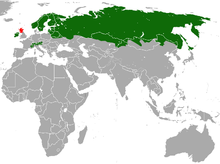- Mountain Hare
-
Mountain Hare [1] 
Mountain Hare in its summer pelage Conservation status Scientific classification Kingdom: Animalia Phylum: Chordata Class: Mammalia Order: Lagomorpha Family: Leporidae Genus: Lepus Species: L. timidus Binomial name Lepus timidus
Linnaeus, 1758
Mountain Hare range
(green - native, red - introduced)The Mountain Hare (Lepus timidus), also known as Blue Hare, Tundra Hare, Variable Hare, White Hare, Alpine Hare and Irish Hare, is a hare, which is largely adapted to polar and mountainous habitats. It is distributed from Fennoscandia to eastern Siberia; in addition there are isolated populations in the Alps, Ireland, Poland, Scotland and Hokkaidō. It has also been introduced to Shetland and the Faroe Islands. The Mountain Hare grows to a length of 46–65 centimetres (18–26 in) and a mass of 2–4 kilograms (4.4–8.8 lb), females being slightly heavier than males .[3]
In Summer, for all populations of mountain hares, the coat is various shades of brown. In preparation for winter most populations moult into a white (or largely white) pelage. The tail remains completely white all year round, distinguishing the Mountain Hare from the Brown Hare, which has a black upper side to the tail .[3] The subspecies Lepus timidus hibernicus (the Irish Mountain Hare) stays brown all year and individuals rarely develop a white coat. The Irish variety may also have a dark/grey upper surface to the tail, which in other populations always remains white. This tail colour combined with its large size (in comparison to most other populations of mountain hare) and the various shades of brown that the Irish hare may display, could lead an unexperienced observer to misidentify an Irish mountain hare as a Brown Hare (Lepus europaeus).
Studies have shown that the diet of the Mountain Hare varies from region to region. It seems to be somewhat dependent on the particular habitat that the population under study lives in. For example, in northern Scandinavia where snow may blanket the ground for many months, the hares may graze on twigs and bark. In areas where snowfall is rare, such as Ireland, grass may form the bulk of the diet. Given a choice, Mountain Hares in Scotland and Ireland seem to prefer feeding on grasses. One study looking at mountain hares on a coastal grassland environment in Ireland found that grasses constituted over 90% of the diet. This was higher than the percentage of grass in the diet of rabbits (Oryctolagus cuniculus) that inhabited the same environment.
In northern parts of Finland, Norway and Sweden, the Mountain Hare and the European Hare compete for habitat. The European Hare, being larger, is usually able to drive away the Mountain Hare but is less adapted for living in snowy regions: its feet are smaller and its winter fur is a mixture of white and brown. While this winter fur is actually a very good camouflage in the coastal regions of Finland where the snow covers the shrubs but for a short time, the Mountain Hare is better adapted for the snowier conditions of the inland areas.
The Arctic Hare (Lepus arcticus) was once considered a subspecies of the Mountain Hare, but it is now regarded as a separate species. Similarly, some scientists believe that the Irish Hare should be regarded as a separate species. Fifteen subspecies are currently recognised .[2]
External links
References
- ^ Hoffman, Robert S.; Smith, Andrew T. (16 November 2005). "Order Lagomorpha (pp. 185-211". In Wilson, Don E., and Reeder, DeeAnn M., eds. Mammal Species of the World: A Taxonomic and Geographic Reference (3rd ed.). Baltimore: Johns Hopkins University Press, 2 vols. (2142 pp.). pp. 204. ISBN 978-0-8018-8221-0. OCLC 62265494. http://www.bucknell.edu/msw3.
- ^ a b Lagomorph Specialist Group (1996). Lepus timidus. In: IUCN 2008. IUCN Red List of Threatened Species. Downloaded on January 28, 2010.
- ^ a b "Mountain Hare". ARKive. http://www.arkive.org/mountain-hare/lepus-timidus/. Retrieved January 28, 2010.
Categories:- IUCN Red List least concern species
- Lepus
- Mammals of Europe
- Fauna of Ireland
- Mammals of Asia
- Arctic land animals
- Fauna of Scotland
- Fauna of the Republic of Ireland
- Fauna of the Faroe Islands
- Fauna of Sweden
- Fauna of Norway
- Mammals of Finland
- Fauna of Russia
- Fauna of Kazakhstan
- Fauna of Estonia
- Fauna of Lithuania
- Fauna of Latvia
- Fauna of Poland
- Fauna of Belarus
- Mammals of Ukraine
- Fauna of Slovenia
- Fauna of Italy
- Mammals of Austria
- Fauna of Liechtenstein
- Mammals of Switzerland
- Fauna of France
- Fauna of Germany
- Mammals of Great Britain
- Animals described in 1758
Wikimedia Foundation. 2010.



